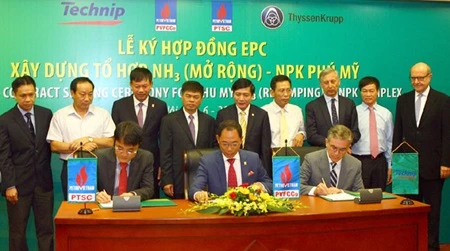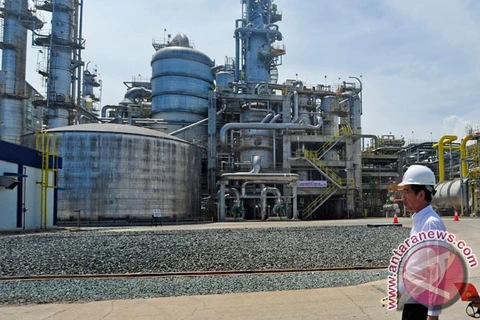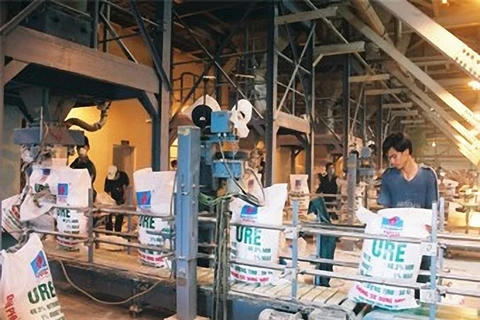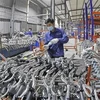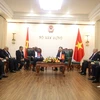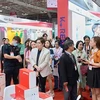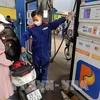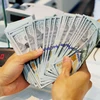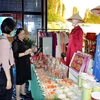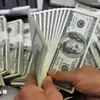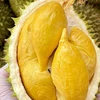Hanoi (VNA) – Vietnam utilises 11 million tonnes of fertiliser annually and its consumption of local products is rising, the Ministry of Industry and Trade said.
Of this, 90 percent of the fertiliser used is inorganic.
More and more domestically produced fertilisers are being used and there is a drop in imported products, the ministry said. In recent years, the country’s fertiliser sector has seen strong growth.
The country has been active in ensuring the supply of urea fertilisers for agricultural production even as it develops new fertilisers such as DAP and kali. Vietnamese fertiliser producers have invested in technologies, equipment and quality of phosphate and NPK fertilisers, the ministry said.
Local producers can meet demands for urea, phosphate and NPK fertilisers, and even manage to export some products to Cambodia, Laos, Indonesia, the Philippines, South Korea and Japan. However, Vietnam still has to import its entire requirement for SA fertiliser.
Nguyen Gia Tuong, General Director of Vietnam Chemical Industry Group (Vinachem), said that in 2017, his company has targeted an industrial production value of 42.4 trillion VND, which is an 8.3 percent rise from last year. Its turnover is expected to reach 43.5 trillion VND, a 3.9 percent year-on-year increase. The company’s units have to increase production to meet the demands for agricultural production and export, he said.
The group is also working to stabilise the domestic fertiliser market and avoid shortage and unreasonable price spike, Tuong said. Vinachem has asked its units to improve trade promotion activities and expand its markets. At the same time, the company is implementing the give-priority-to-Vietnamese goods policy to increase utilisation of rubber, phosphate, urea and DAP fertilisers.
Vinachem has requested the ministry to take drastic measures to stop the sale of poor-quality and fake fertilisers as well as curb trade fraud so that the business environment is healthy. It has called for trade defence measures such as imposing an anti-dumping tax on urea and DAP-imported fertilisers.-VNA
Of this, 90 percent of the fertiliser used is inorganic.
More and more domestically produced fertilisers are being used and there is a drop in imported products, the ministry said. In recent years, the country’s fertiliser sector has seen strong growth.
The country has been active in ensuring the supply of urea fertilisers for agricultural production even as it develops new fertilisers such as DAP and kali. Vietnamese fertiliser producers have invested in technologies, equipment and quality of phosphate and NPK fertilisers, the ministry said.
Local producers can meet demands for urea, phosphate and NPK fertilisers, and even manage to export some products to Cambodia, Laos, Indonesia, the Philippines, South Korea and Japan. However, Vietnam still has to import its entire requirement for SA fertiliser.
Nguyen Gia Tuong, General Director of Vietnam Chemical Industry Group (Vinachem), said that in 2017, his company has targeted an industrial production value of 42.4 trillion VND, which is an 8.3 percent rise from last year. Its turnover is expected to reach 43.5 trillion VND, a 3.9 percent year-on-year increase. The company’s units have to increase production to meet the demands for agricultural production and export, he said.
The group is also working to stabilise the domestic fertiliser market and avoid shortage and unreasonable price spike, Tuong said. Vinachem has asked its units to improve trade promotion activities and expand its markets. At the same time, the company is implementing the give-priority-to-Vietnamese goods policy to increase utilisation of rubber, phosphate, urea and DAP fertilisers.
Vinachem has requested the ministry to take drastic measures to stop the sale of poor-quality and fake fertilisers as well as curb trade fraud so that the business environment is healthy. It has called for trade defence measures such as imposing an anti-dumping tax on urea and DAP-imported fertilisers.-VNA
VNA

